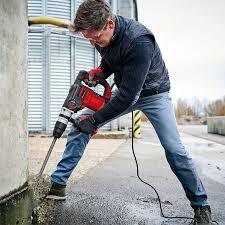Hammer Drill: The Mighty Tool for Your DIY Adventures
If you’ve ever stared at a wall and thought, “I could really use a hole here,” then a hammer drill might just be your new best friend. Whether you’re hanging pictures, installing shelves, or pretending to be a contractor in your own garage, this tool is a game changer. Let’s dive into the world of hammer drills, where construction magic happens and where your home improvement dreams take flight—or at least don’t end in disaster.
What Is a Hammer Drill?
A hammer drill is a power tool that combines the functions of a regular drill with a hammering action. It’s like a drill that had too much coffee and decided it needed to punch its way through concrete. While a standard drill rotates the bit to create holes, a hammer drill adds a back-and-forth motion, allowing it to tackle tougher materials like brick, masonry, and concrete. This dual action means you can go from “just trying to hang a shelf” to “I’m basically a construction worker” in no time.
How Does It Work?
Think of a hammer drill as a dance partner that knows all the right moves. The drill bit spins, while the hammering mechanism provides quick bursts of force. When you press the trigger, the drill bit rotates, and the hammering action pushes the bit in and out. This combination makes it easier to drill into hard surfaces without losing your sanity—or your patience.
Different Types of Hammer Drills
Not all hammer drills are created equal. Here’s a quick breakdown of the main types:
- Corded Hammer Drills: These tools are powerful and won’t run out of battery mid-hole (which is a blessing). However, you’ll need an outlet nearby and might trip over the cord—so watch your step!
- Cordless Hammer Drills: The freedom of mobility! You can dance around your workspace without worrying about cords getting in your way. Just remember to charge the battery. Nothing is worse than getting excited to drill only to realize you’re out of juice—talk about a buzzkill.
- Rotary Hammer: If you’re planning on taking down walls (no one said that, right?), a rotary hammer is your go-to. It’s more powerful and designed for heavy-duty work. Just make sure you’re wearing your superhero cape because this tool can make quick work of concrete.
Why You Need a Hammer Drill
If you’re still on the fence about getting one, let’s break it down. Here are some reasons why a hammer drill should have a special place in your tool arsenal:
- Versatility: Whether it’s a drywall, wood, or concrete job, a hammer drill can handle it. It’s like having a multi-tool that just gets things done.
- Time-Saver: You’ll be amazed at how quickly you can make holes in tough materials. Less time drilling means more time to contemplate life’s big questions—like why you can never find matching socks.
- Less Strain: Hammer drills do most of the hard work for you. So, instead of straining your wrist and wondering if you’ll ever be able to open a jar again, let the drill take on the tough stuff.
Choosing the Right Hammer Drill
Now that you’re convinced a hammer drill is essential, how do you choose the right one? Here are some tips:
- Power: Look for a drill with at least 7 amps for corded or a voltage of 18V or higher for cordless. You want something that doesn’t struggle to get the job done—think of it as looking for a friend who can handle the spice level in your favorite dish.
- Weight: If you plan on using it for extended periods, consider the weight. You don’t want to feel like you’ve just completed a triathlon after hanging a picture frame.
- Speed and Torque Settings: Having adjustable speed settings allows you to tackle different materials effectively. It’s like choosing between a slow dance and a high-energy shuffle.
- Ergonomics: A comfortable grip is essential. After all, you don’t want to drop your new favorite tool just because it feels like holding a brick.
Tips for Using a Hammer Drill
Using a hammer drill is not rocket science, but a few tips can make your experience smoother—and maybe even a bit more fun:
- Mark Your Spot: Before you start drilling, mark where you want to make that glorious hole. Trust me, drilling a hole in the wrong place can lead to more problems than it’s worth. “But it’s a design feature!” said no one ever.
- Use the Right Bit: Make sure you have the correct drill bit for the material you’re working with. Using the wrong bit is like trying to slice bread with a hammer—effective? No. Funny? Definitely.
- Go Slow: When starting, apply gentle pressure. You’re not trying to conquer Mount Everest—just make a hole. Let the drill do the heavy lifting.
- Wear Safety Gear: Safety glasses and ear protection can save you from unexpected debris and the sound of your own excitement. Remember, safety first, shenanigans later!
- Take Breaks: If you’re drilling into tough materials, take breaks to avoid overheating the drill. Plus, it gives you a chance to stretch and show off your best “I’m a hard worker” pose.
Common Mistakes to Avoid
As you embark on your hammer drill journey, here are a few pitfalls to avoid:
- Drilling Too Fast: While it’s tempting to unleash the power of your drill, going too fast can lead to mistakes. Slow and steady wins the race, even if you’re not racing anyone but your own impatience.
- Forgetting to Clear Dust: Dust can build up quickly, especially in masonry work. Don’t forget to clear it away to see your progress—or you might end up drilling in the dark.
- Ignoring Material Differences: Not all surfaces are the same. What works on wood won’t necessarily work on concrete. It’s like trying to use ice cream to fix a flat tire—just doesn’t work.
Maintenance Tips
To ensure your hammer drill stays in top shape, follow these simple maintenance tips:
- Clean It Regularly: Dust and debris can accumulate in the motor. Give your drill a gentle clean now and then to keep it happy and functional.
- Check the Bits: Worn-out bits can lead to poor performance. Inspect them regularly and replace as needed—because nobody likes a dull tool, just like nobody likes a dull conversation.
- Store Properly: Keep your hammer drill in a dry place, away from extreme temperatures. Treat it like the beloved companion it is, not just a piece of equipment shoved in the corner.
Conclusion
A hammer drill is an incredible tool that can make DIY projects feel less daunting and a lot more fun. Whether you’re a seasoned pro or a weekend warrior, having one in your toolkit can elevate your home improvement game to new heights. Remember, with great power comes great responsibility—and hopefully, a lot of laughter and satisfaction as you turn those “what if” ideas into reality.
So, go forth and conquer those walls, but don’t forget to take a step back now and then to admire your handiwork. After all, every hole you make is a small victory in your journey as a DIY master (or at least a competent amateur). And who knows? You might even discover a hidden talent for drilling—just be careful not to start charging your neighbors for your skills!










